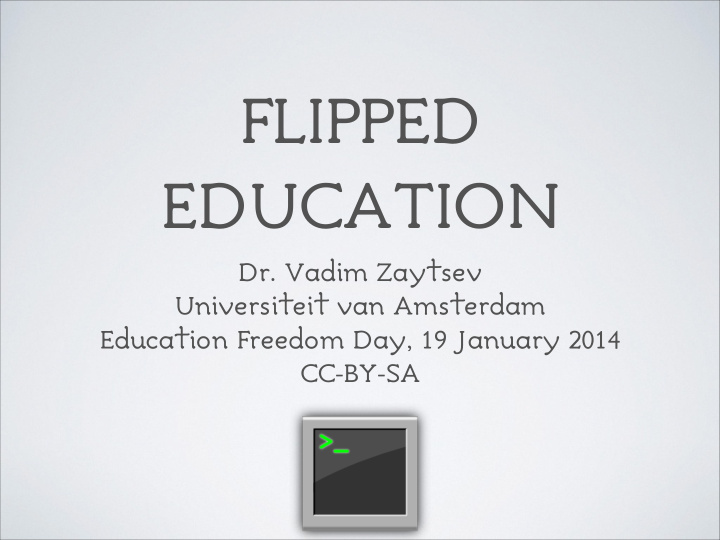



FLIPPED EDUCATION Dr. Vadim Zaytsev Universiteit van Amsterdam Education Freedom Day, 19 January 2014 CC-BY-SA
Introduction • Vadim Zaytsev • aka @grammarware • teaches at UvA • worked at CWI (Amsterdam) • worked at Uni Koblenz (Germany) • studied at VU (Amsterdam), UTwente (Enschede), … • software language engineer
Classic education Ikiwaner, Gambian classroom, 2008. CC-BY-SA.
Classic education Je ff chenqinyi, Big classroom, 2013. CC-BY-SA.
Flipped education Onderwijsgek, Empty classroom, 2011. CC-BY-SA.
Freedom in flipped
Flipped education • Lecture element & homework element are reversed • “Sage on the stage” => “guide on the side” • Lectures are pre-recorded & made available • Known since 199x, popular in 201x • Claimed better use of class time • Not a silver bullet 7 Things You Should Know About the Flipped Classroom (EDUCAUSE, 2012, CC-BY-NC-ND)
Classic education Students Instructor Before class Homework (reading §§) “Homework” (prep) In classroom No idea Assume usability During class Follow Get through A ! er class Homework (assignments) “Homework” (grading) Away Request confirmation Repeat WHAT is the Flipped Classroom? (University of Texas at Austin)
Flipped education Students Instructor Before class Learn & answer questions “Homework” (prep) In classroom Specific questions Anticipate questions During class Practice skills being learnt Guide with feedback A ! er class Continue to practice Post additional info Away Seek help when needed Continue to guide WHAT is the Flipped Classroom? (University of Texas at Austin)
Usually vs. flipped • Usually in class (at home when flipped) • Lectures • Exams • Usually at home (in class when flipped) • application
Consequences [1/5] • Better utilisation of teachers? • one to one interaction • Better pacing of the learning process • students decide on their own • never progress without mastery Daniel Grafton, The Fuss Over Flipped Classrooms, 2012.
Consequences [2/5] • Solves the absentees problem (kinda) • sick/away/resting => miss nothing • Provides lots of data for improvement • diagnostic possible • teachers can improve courses Daniel Grafton, The Fuss Over Flipped Classrooms, 2012.
Consequences [3/5] • Restructured material • typically one video is 5-15 min long • Enables other sources of info • friends, parents, interwebz • Increases “screen time” • watching is lecture is HCI Daniel Grafton, The Fuss Over Flipped Classrooms, 2012.
Consequences [4/5] • Uncontrolled environment • many flipped courses => hours of videos every day! • some have more/better hardware • suboptimal conditions Daniel Grafton, The Fuss Over Flipped Classrooms, 2012.
Consequences [5/5] • Lots of work! • no time for prep? • unmotivated students? • underqualified teachers? Daniel Grafton, The Fuss Over Flipped Classrooms, 2012.
Results KNEWTON, The Flipped Classroom (made from other sources)
Summary • Classwork / homework flipped • Teachers provide videos, tests, feedback • Theory is learnt at home • Application is learnt in the class • Works if everybody is motivated/smart
Matthew J. Koehler, The TPACK diagram, tpack.org
Places to know
How to flip YOUR classroom • Where this makes sense for your course • Spend class time on feedback • Clarify connections classwork/homework • Adapt your materials • Extend learning beyond class Flip Quick-start Guide (University of Texas at Austin)
Further reading • A.Kohn (2006). The Homework Myth: Why Our Kids Get Too Much of a Bad Thing. • J.Bergmann, A.Sams (2012). Flip your classroom: Reach every student in every class every day. • D.Berrett (2012). How flipping the classroom can improve the traditional lecture. • R.R.Hake (1998). Interactive engagement vs. traditional methods: A six- thousand student survey of mechanics test data for introductory physics courses. • S.Zappe, R.Leicht, J.Messner, T.Litzinger, H.W.Lee (2009). Flipping the Classroom to Explore Active Learning in a Large Undergraduate Course.
• Sources? • given on the bottom of each slide • Slides? • http://grammarware.net/talks/#EFD2014 • Fonts? • Avdira — George Douros, Unicode Fonts for Ancient Scripts, 2009. • Finger Paint — Ralph Oliver du Carrois, 2013. • Questions?
Recommend
More recommend